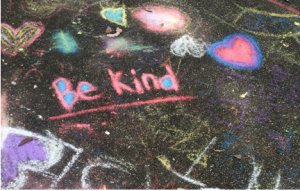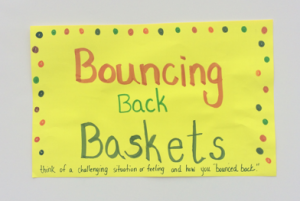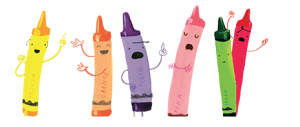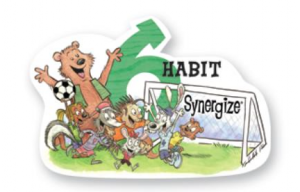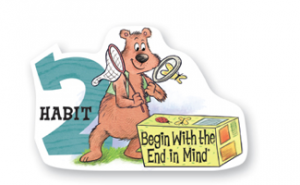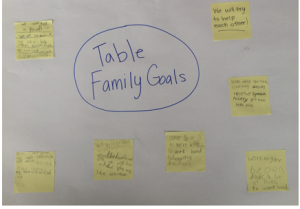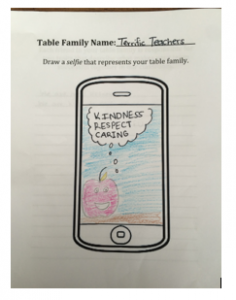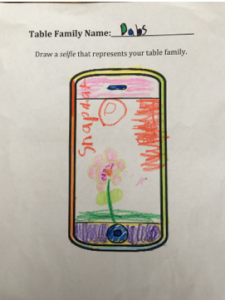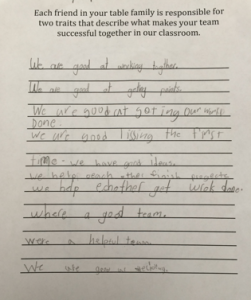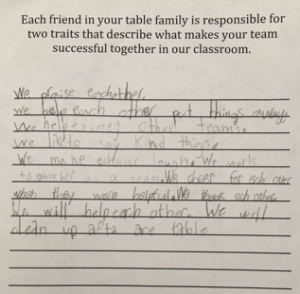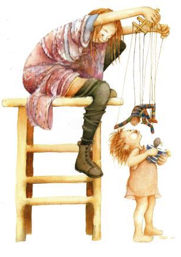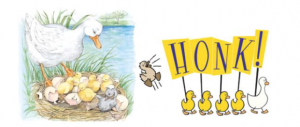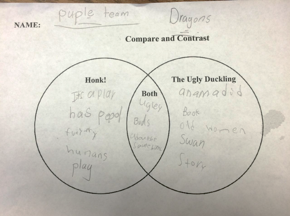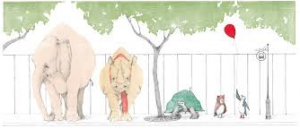Social and Emotional Learning by C. Landau
“[S]chools in both the United States and various other countries have begun to include social and emotional learning into their curriculums due to a variety of studies that have proven the benefits of getting into touch with one’s own emotions and others’ emotions. Elementary, middle, and high schools have all begun to include various activities and programs that encourage social and emotional learning.
Louisiana is one of the many states that have adopted Common Core standards, and these standards emphasize the need for socialization in students as early as Kindergarten. For example, Louisiana’s Kindergarten English Language Arts/Literacy Standards include a section for speaking and listening standards. These standards comprise of participating in collaborative conversations with diverse partners in small and large groups, following rules for discussions such as listening to others when they speak and taking turns talking, and continuing a conversation through multiple exchanges. These principles are encouraged in schools throughout the state, such as Lusher Charter Elementary School where students in all grades take time throughout their week to socialize and reflect on their emotions. At Lusher, kindergarteners and fifth graders pair up at least once a month to practice conversational skills, all grades participate in “caring counts” meetings at least once a week to express thoughts and emotions, and classrooms for lower grades include “safe space” areas where students can take time to get away from the commotion of the classroom if they feel overwhelmed by some negative emotion. These are just a few of the practices that Lusher implements to encourage social and emotional learning, and Lusher is one of the many schools throughout the state that participates in such activities.”
This excerpt is from a research reflection written by TPCP student Chelsea Landau, Class of 2016
Feel With It! Teaching Children SEL Lessons and Learning with Them
Former residency student Erin Weisman (weisman.erin@gmail.com) documents the social and emotional learning and teaching at Lusher Charter Elementary School. Read her engaging blog entries for ideas on how the campus and her second grade class (under the mentorship of Ms. Bonnie Bowler) incorporate empathy, kindness, goal-setting, and so much more:
Arts Integration and Empathy Jan 13
Lusher Elementary Charter School has an amazing social emotional program. I am a student teacher in their second grade, and help execute their weekly social emotional learning lessons. With a fast approaching field trip to the Louisiana Phil Harmonic, it was important to teach the students proper audience etiquette, and we used that opportunity to also help our students deepen their understanding of empathy.
We watched a very sweet video in which a teacher and several elementary school aged students were watching a classical music performance. They accidentally did several audience member gaffs and were corrected by the performers. They ate noisy foods, played on electric devices, and talked during the singing.
We asked the students to stop and think, “How would I feel if I was doing something I felt was important, and someone was doing one of those things to interrupt me?” The students shared different ways they would feel if people were rude while they were sharing. Several students confessed that they would not want to share again if they were interrupted the way the artists had been in the video.
After student reflection, we discussed what these ideas are called. We talked about how important it is to show respect to others. An easy way to remember to be respectful, the class decided, was to have empathy. If you can put yourself in another person’s shoes and imagine how they are feeling, it is easier to treat them the way you would want to be treated.
As a formative assessment, we tried to come up with strategies for expressing ourselves at the performance without being disrespectful or hurting the musicians feelings. The students decided that the best way would be to use your facial expressions to show how you are feeling and to clap after it was over if you liked it.
The students were so engaged in the video that they were yelling at the bad examples on the screen. They were begging them to follow the rules by the end of the lesson. I love how this lesson got the students excited about the upcoming performance as well as being respectful. We used language like, “express yourself with your face instead of your body”, and during the field trip, the students used that same language. It was really rewarding to see the lessons we learned in class be put to real-world use on our field trip.
Finally, the video brings up an interesting point that I had not thought of. Different events require different levels of participation and respect from its audience members. A rock concert is a good environment for singing along and dancing, but you would not do that at a classical symphony concert. You might shout and eat at a sporting event, but you wouldn’t do that at a friend’s recital. After seeing this lesson and its benefits in action, I now realize that teaching these distinctions is just as important as teaching the students respect and empathy.
Kindness at Play January 26th
Every Wednesday morning, Lusher Elementary students participate in Caring Counts meetings where they learn different strategies for expressing how they feel in social situations they encounter every day. This meeting is an open and caring environment through which students learn both from each other and their teachers.
In late January, Lusher held a special Caring Counts program that took over the play yard and enriched the students’ recess time with social emotional learning activities. In addition to the usual playground activities, there were several stations that fostered different aspects of the school’s most important rule: Be Kind.
On the blacktop, the students would write down frustrations they have faced in the past and shared ways they could “bounce back” from those disappointments. Then these students were asked to think of those experiences while shooting a basketball against a high backboard. Every time the ball returned to the student, it represented the resiliency they showed in the face of negative experiences. Students clamored to get in line and shoot their disappointments at the backboard. This lesson is a fun and interactive way for students to learn what resilience means. If you have a class of wrestles students, this activity is a fun way to let them release some energy out on the yard while teaching the importance of “bouncing back”.
Similarly, another station was set up like a small soccer field. There were three small, portable goals set up against a wall. On the other wall was a table set up with slips of paper and pens. The students wrote down goals they had for themselves for the future. Then they were asked to imagine the soccer balls as those goals. We taught the students that it isn’t always easy to achieve your goals on the first try, but with hard work, it will be easier. This lesson is a kinesthetic way for students to build an internal locus of control. Students recognize that they are in control of their future, and the choices they make (working hard or not) determine whether or not they can achieve their goals.
At another station, children wrote down kind acts they had seen their peers do throughout the year on paper links. Then we would attach the links together. After we finish putting together all of the links, the Kindness Chain will be hung up around the school. This was a sweet way to show children that a little bit can go a long way. Small acts of kindness can inspire more and more kindness until the entire school is involved. It is a good way for the students to watch their ideas of the school rules physically come to life around their campus.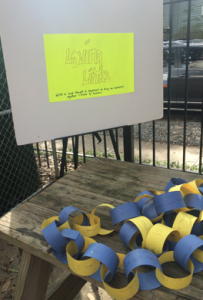
All over the yard that day students were learning and laughing together about all of the kindness they experience on campus, but we also talked about what we wished we saw more of. Many children wished they had more friends with whom to play, some experienced unkind actions from their peers and came up with strategies to combat that. We felt it was important to keep the children creating. No community is perfect, and if the students wish to see a change in theirs, they should have a voice.
There are too many lessons in schools these days that involve sitting at a desk or filling out worksheets. With hands-on lessons like these, students get to see how information they learn can be manifested in real life.
Life is Like a Box of Crayons February 1
As part of our Caring Counts meetings every week, we start with a quick check-in with each of the students. Students have about ten seconds to share anything they want, and if they can’t think of something they want to share, they tell what they had for dinner the previous night. This gives every child the opportunity to feel recognized by peers and teachers, while also providing the teacher an opportunity to take roll. Around this time of year, our students are all excited about the parades each weekend during Carnival Season. If the other children have positive feelings about what their friends have shared, they express their reactions with thumbs up or a smile—it is important that no one gets interrupted during their share in order for this strategy to be effective.
This week, we read The Day the Crayons Quit written by Drew Daywalt and illustrated by Oliver Jeffers. This is a truly charming story about a small box of crayons in which each crayon has a complaint about its position in the coloring utensil hierarchy. Each page is a different letter to the box’s owner detailing each crayon’s grievance. Some feel over-worked, some feel under-appreciated, and some letters represent a back-and-forth conflict among the crayons themselves. This story can be read to teach many social emotional lessons. We used it to talk about working as a team, communication, and making compromises.
Our class is full of hard-working, kind students, but we often struggle with non-conflict group work. We discussed how without open communication, partners or table family members can’t read our minds and give the help that we need. We commended the crayons for respectfully telling their owner how they feel, and talked about different ways to tell someone that we are having an issue.
Additionally, we talked about how important it is to make compromises when working as a team. Not everyone can get exactly what they want on every decision, and we need to recognize what is important for the whole group. The students had fun putting themselves in the crayons’ shoes and comparing their real- life team challenges with the problems the crayons were having.
This is a long story; it has many pages and a subtle pattern of repetition, so in order to keep your students engaged the whole time, I would recommend using a different voice for each crayon. It gets challenging towards the end—how many voices can one person create? But in my experience, the students were eager for each turn of the page if not only to hear what their teacher would come up with next. It is also helpful for keeping all of the different characters straight.
As a follow up technique, teachers can start referring to table groupings as boxes of crayons. This helps the students make the connection between the story, and the class discussion. Teachers can use phrases in times of conflict like, “Think of the needs of the other crayons” or, “This box of crayons is working so nicely together!” Students will be able to use this metaphor to aid their team building skills and work more efficiently (as well as peacefully) with their partners.
Can You Hear Me Now? February 17
For this week’s Caring Counts meeting, we wanted to focus on the difference between listening and hearing. Our class of second grade students often struggles with listening. It can be challenging to have effective group or partner activities when the children talk over each other and speak while we are giving instructions. Many of the social issues we encounter in our class are related to feeling frustrations when students’ peers do not listen.
First, we introduced the comparison between hearing and listening. Students “popcorned” to offer ideas of what the difference could be. For this type of exercise, after we pose a question to the seated children, they jump up to standing if they have an answer ready. This is a great way to get your students moving in a structured and small-scale way during instructional time.
To incorporate literature into our social-emotional lesson, we read “Jumper and the Lost Butterfly Net” from a collection of stories in The 7 Habits of Happy Kids. 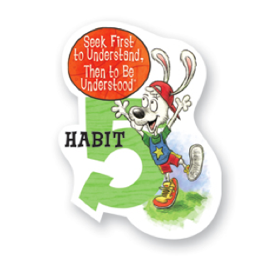
This short story details the adventures of an impatient bunny that does not listen to his friends. It seems like all he cares about is going out to play even when his friends are feeling upset or have a problem with which they need help. Jumper hears the words his friends are saying, but he does not listen to what his friends need. A wiser character from this story tells Jumper that listening involves more than your ears. In order to understand what your peers are saying and what they really mean, you have to use your eyes and your heart in addition to your ears.
When relaying this idea to your students, it is important to recognize that some children might not have access to their sight or their hearing. In order to be inclusive, I suggest that to listen, you need to pay attention to how the speaker is using their words. If they are upset, someone who cannot hear might be able to see a facial expression, while a person who cannot see could hear a specific tone of voice. When Jumper’s wise friend suggests that you need your eyes to listen, you can interpret that as needing a deeper understanding.
After reading the story with varied voices for the different characters to engage the students, we had them stand up and pair up to discuss what they would prefer—to be heard or to be listened to. Unanimously, our class decided that listening was more meaningful than simply hearing.
We were excited to notice that throughout the day after this lesson that when a student felt like their partner or teammate was not paying attention, they kindly reminded them to choose listening instead of hearing. This vocabulary can be incorporated into the classroom diction for the rest of the year as a quick and easy way to remind students to politely and actively listen to the speaker.
Making Our Goals February 24
Following the theme of teamwork, this week we read another story from 7 Habits of Happy Kids. We often struggle in our classroom with partner and teamwork. While we have been talking about working together for many weeks now, we are focused on spiraling the strategies we have already learned by adding new ideas to our Social Emotional toolbox.
In “The Big Bad Beavers”, our fury friends come up against a tough soccer team to beat. In the first half of the game, the Beavers work together and score two points while our group of protagonists struggle to play as a team. Each player tries to succeed by working independently. Without teamwork, they fall behind in the goal count.
At this point in the read aloud, I paused and had my students discuss what they inferred (a spiraled literacy concept) the problem might be with our friends’ strategy. My second grade students unanimously agreed that the main characters were losing the soccer game because they were not working together. As a class, we brainstormed different ideas that the team could use to work better as a group. One student suggested they make a plan that gives each friend a specific job.
After we made our predictions, we continued to read. From this point on in the story, the friends work together to score goals. Each team member does their part and helps the whole team win the game. When the story is over, we related the soccer game to activities and projects we do in class. We discussed the fact that we need teamwork for most of what we do in our room every day. I suggested that when we “Sage and Scribe” (a Kagan social learning method with which students alternate writing and dictating the answers to a problem set) during Math lessons, our partner groups that finish more quickly and more happily are teams that work together. On the other hand, I notice that the teams who need extra time or tend to argue are the pairs that are not working together.
We added the phrase, “Try to win your soccer game” to our lexicon of Social-Emotional language. At this point in the year we now have several sayings to remind us to be kind to each other and work together. It is truly exciting to watch our tool boxes fill up and to hear the students using the language to kindly remind each other throughout the year.
—————————————–
March 9
During our Caring Counts quick share this morning, over half of my 22 students shared that they were saving money for a fund. I was so excited and proud to hear my students using our vocabulary words. To tie our budgeting unit together with our continuous need for team building, I chose a story about making goals.
In 7 Habits of Happy Kids, “Goob and the Bug Collecting Kit” teaches the importance of making a goal before starting an activity and sticking to that goal to be successful. Our Bear friend Goob has had his eye on a bug collecting kit for himself for a while. However, he also has a long list of items he needs to buy—both for himself, and for his peers. Before even making a fund-raising plan, Goob drafts a detailed budget plan. When he raises enough money, he successfully reaches his goal to buy everything on his list because he sticks to his plan. His friend Jumper spends all of his money on random items and does not save enough to go to the movie theater later.
We talked about what Goob’s goals were and how he successfully attained them by making a plan. This story was the perfect transition from budget vocabulary to learning how to set goals. Recently, we rearranged our table family groups to try to find a better working combination of students. In order to foster team building among these new groupings, we made a list of goals for each individual team. I posted a class circle map with “Table Family Goals” as the center topic. Each team received a post-it note on which to brainstorm goals for their specific family to strive to attain.
Many children suggested that using kind words with their family would be helpful; others hope to work together to make sure everyone is paying attention (and more). Once each table family had filled their post-it note with goals, we pasted them to our circle map. Throughout the day, students referred back to their goals on our map to remind their groups of what they want to achieve. All day my students were encouraging each other to follow directions and congratulating each other when they were successful. I will continue to spiral this idea of making goals to work as a team in future Caring Counts meetings in order to maintain and grow this exciting progress.
———————————-
Taking a Look at Our Selfies March 30
Every week, we learn the academic term for a simple concept we already know. Teaching students to use academic language fosters higher-level thinking and application. Often times, adults underestimate the academic level young students are capable of, but using academic language encourages mutual respect and a curiosity in the classroom.
This week we are learning about Character Traits. We define these traits as the ways in which a person speaks, acts, or thinks. Instead of doing a literacy-based social-emotional learning lesson, I wanted to build our trait schema. Children learn more effectively when they can assimilate new information with previous knowledge.
I made an exemplar and projected it on the board. In my example, I created a fake table family for our teaching team. On the back, I wrote two traits and drew a selfie in the phone on the front. The students could refer to this example throughout the activity. I suggested that students start with the writing section and then draw their selfie.
Keeping on track with our team building activities from previous caring counts meetings, we linked these team builders with the academic language. I made an activity sheet called the “Table Family Selfie”. On one side there are lines for writing. The students were to write down traits their table family has that help them be successful and then work together to draw a selfie in the phone that represents their team. Each student is responsible for writing two traits.
We discussed the difference between an individual’s trait and a team trait. If only one of the members has a particular trait, then it is not a family trait. We agreed that if not everyone agreed that the family has a suggested trait, then it is not a team trait and cannot be written down.
Some teams had an easy time coming up with positive family traits and others struggled. One of my groups met with a challenge when not every member of the team agreed. I reminded this family that without a unanimous feeling, it cannot be written down. These students had to reflect on their experiences as a team to determine if they do have the trait they disagreed on. Ultimately, they decided that sometimes they use kind words with each other, but other times they struggle using a friendly language. They agreed that because they don’t always have the trait, they would not put it down. By the end of this activity, it was very exciting to see all the different entry points each team used to create their selfies.
This activity successfully spiraled the academic concepts of character traits and also reinforced our team-builders.
Making Memories Together April 6
As a continuation of the Selfie lesson we did for last week’s caring counts meeting, we talked about making positive memories. Additionally, this week our academic terms include Graphic Features. I read the book Wilfrid Gordon McDonald Partridge by Mem Fox. This story discusses what the idea of memories means to different people.
Before we read this book, we talked about what our ideas of what memories are. Most of the students agreed that memories are things that happen in the past that we remember. One student suggested that memories are happy thoughts from the past. We discussed that memories can involve any emotion. Some memories are happy, but some are sad, some are scary, and so on…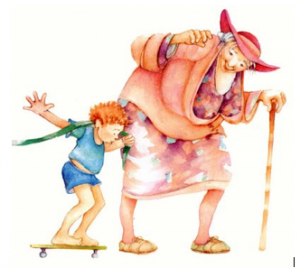 In Wilfrid Gordon’s story, he is a little boy who lives next door to an old person’s home. His best friend is an old woman who lost her memory. He spends most of the story asking his family and the other older people who live in the old folks’ home what “memory” means to them. Each person he asks has a different answer. In the end, Wilfred Gordon helps Miss Nancy (his friend) recall her memories by sharing his own.
In Wilfrid Gordon’s story, he is a little boy who lives next door to an old person’s home. His best friend is an old woman who lost her memory. He spends most of the story asking his family and the other older people who live in the old folks’ home what “memory” means to them. Each person he asks has a different answer. In the end, Wilfred Gordon helps Miss Nancy (his friend) recall her memories by sharing his own.
When Miss Nancy is sharing her memories, the illustrations show her as how old she was when the memory was made. We talked about how the graphic features in the part of the story are memories and which parts are happening in the present.
After reading together, we realized that pictures are a good way of saving memories. The Table Family Selfies from last week’s meeting are ways we can save memories of our table families. The students then voted on what type of memories they wanted to make together. Out of Happy, Frustrated, Exciting, Fun, and Sad, Fun won unanimously. Then, we split into our table families and brainstormed different ways to make sure we have fun memories (rather than frustrating memories).
Throughout the rest of the day, we used the language “let’s make fun memories” to remind students when they need to work as a team.
Honk If You Care! April 13
In our literacy lessons this week, we are learning about comparing and contrasting. Oftentimes, my students struggle to find similarities (compare) and when they find differences (contrast), they tend to be superficial. Earlier in the week, we went to the Middle School’s performance of “Honk!”—a musical interpretation of The Ugly Duckling. For our Caring Counts meeting this week, we compared and contrasted “Honk!” to a picture book telling of the ugly duckling story.
Before we watched the read aloud, we talked about the behavior we observed from the characters in the musical. My students noticed that at the beginning of the production, everyone was mean to the duckling, but by the end, everyone treated him with kindness and respect.
I asked students why the other characters changed the way they treated the duckling. One of my second graders suggested that the other birds stopped teasing the duckling when he became beautiful. This realization prompted a deeper discussion of what true kindness is. The children concluded that it’s not really kindness if it’s based on looks. We agreed that the “ugly” duckling should not have been bullied from the very start. In our classroom, we’ll treat people with kindness and respect because that is how we want to be treated not because someone is beautiful.
When we watched the storybook read aloud version of The Ugly Duckling, I stopped the video throughout to scaffold, comparing and contrasting this story to “Honk!” After the six-minute video ended, we split into table families to participate in a round robin of ideas of how the two versions were different and how they were similar. Each team received a Venn diagram. One circle was labeled “Honk!,” one “Both,” and one “The Ugly Duckling.” Every student was responsible for at least one idea. This lesson helped reinforce our ideas of empathy and helped review our academic language as well.
Supporting Learning April 20
Our literacy lesson this week focuses on defining the main idea of a story and supporting details. In our class, we’ve agreed that our working idea of what supporting details do is that they hold up the main idea. For Caring Counts this week, I took the concept of support and we made connections between being a supportive friend and being a supportive detail.
I introduced this SEL lesson by discussing out essential questions:
- What does “support” mean?
- How can we support our friends?
- How can details support a main idea?
In order to encourage total class participation, I implemented wait time after posing my questions and pulled sticks. Each Popsicle stick has a different student’s name on it. Using the stick cup is a good way to determine if all students are paying attention.
My students suggested that a supportive detail is very similar to a supportive friend. They both support something by holding it up. A supportive detail adds information that the main idea relies upon and a supportive friend can offer help or kindness that a person can rely on. To explore both of these ideas, we watched a read-aloud video of A Sick Day for Amos Lee.
In the beginning of this story, a kind and caring zookeeper takes care of all the animals. He does specific things to support each animal’s different needs. Then one day, Amos became sick. He was so sick that he couldn’t go in to work and take care of his animal friends. When the animals realized that Amos wasn’t coming, they went to his house to take care of him.
Each animal supported Amos in their own way. We discussed the main idea. One student offered that the main idea is “if you help others, other people will help you even if you have a disease.” Then, other students shared supporting details from the story that hold up the main idea. To wrap-up, we connected the friendships from the story to our teams in class. I asked how can we support the other people in your table family? Some friends suggested being kind, others suggested offering help on challenging class work. Throughout the rest of the day, we reminded the students that to be successful, they need to support each other
——————————————————————————————
*All of the entries on this page were written by Erin Weisman, Tulane University, Teacher Preparation and Certification Program.
